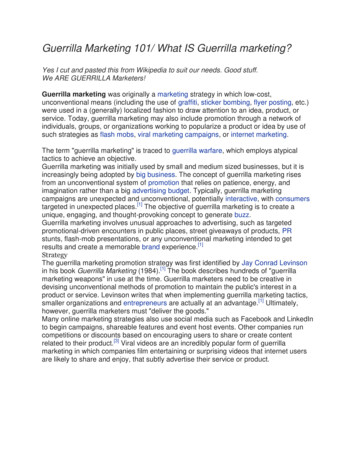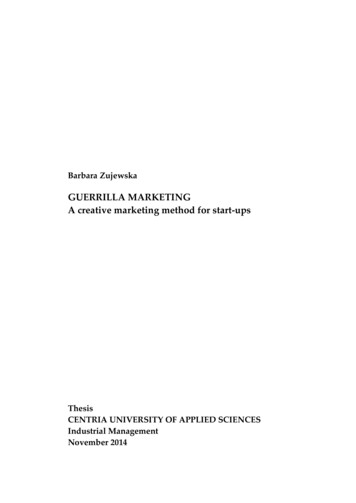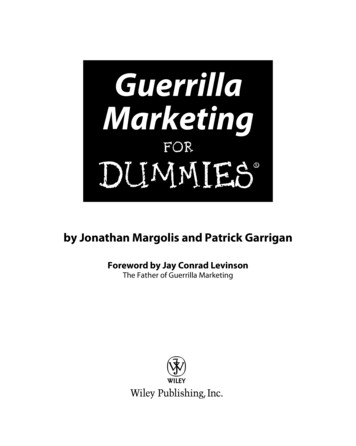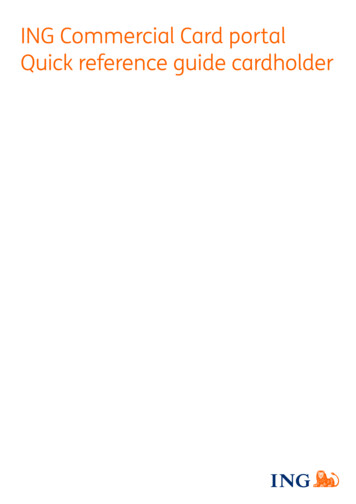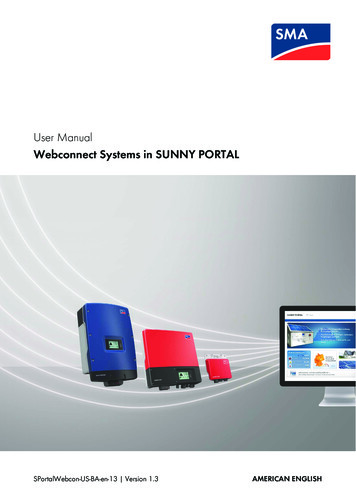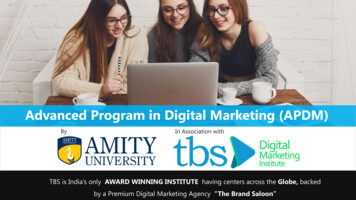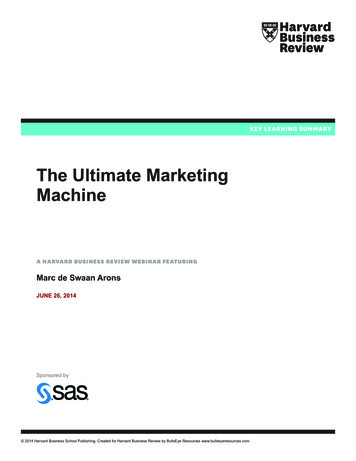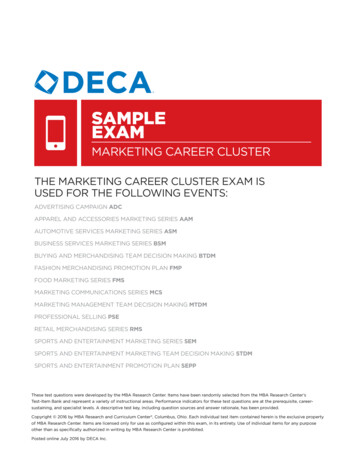
Transcription
BACHELOR THESISSpring 2012Kristianstad UniversityInternational Business and Economics ProgramGuerrilla Marketing- And its Effects on Consumer BehaviorAuthorsSandra BelićEmelie JönssonSupervisorChrister EkelundExaminerTimurs Umans
AbstractAs consumers are getting better at avoiding the traditional marketing campaignscompanies are using, it has become crucial for companies to differentiate theirmarketing. One way of doing this is to use guerrilla marketing, a marketing type moreextreme, innovative and attention capturing than traditional marketing.The purpose of this thesis is to explore how the use of guerrilla marketing affectsconsumer behavior in terms of brand attitude, brand image and purchase intention.Moreover, the effect on Word-of-Mouth will be explored, as this is a crucial implicationif the guerrilla campaign is to be perceived as successful.Based on marketing theories and consumer behavior theories, an experiment isconducted through a focus group seminar, to determine if guerrilla marketingcampaigns are perceived as being more creative and credible than traditional marketingcampaigns. Furthermore, these determinants are used as instruments to study the effecton brand attitude, brand image and purchase intention. The study is exploratory and thechosen method is a qualitative data collection.The findings indicate that guerrilla marketing campaigns affect all consumer behaviorelements, studied in our thesis, more than their equivalent traditional marketingcampaigns. Suggestions for further research include studying if there is a culturaldifference in how guerrilla marketing is perceived.This thesis may be useful in increasing companies’ understanding of the concept ofguerrilla marketing and how this can be used in a successful way.Keywords Guerrilla Marketing, Consumer Behavior, Brand Attitude, Brand Image, Purchase Intention,Word-of-Mouth
AcknowledgementDuring the writing process of this thesis, several people have supported us and wewould like to take this opportunity to thank them all.First of all, we would like to thank the participants of our focus group seminar fortaking the time to provide us with interesting answers to our questions. Secondly, wewould like to thank our supervisor, Christer Ekelund, for all the interesting discussionsleading to the improvement of the quality of our thesis. Thirdly, we would like to thankAnnika Fjelkner for all her help with the English language. Finally, we would like tothank our examiner Timurs Umans, for evaluating our thesis.Last, but not least, we would like to thank our families and friends for all the supportand love.Thank you.Kristianstad, May 2012Sandra BelićEmelie Jönsson
Table of Contents1. Introduction 61.1 Background 61.2 Problem formulation 71.3 Research purpose 81.4 Research question 81.5 Limitations 81.6 Outline of the thesis 82. Theoretical Framework 102.1 Marketing 102.1.1 Communication 112.2 Transactional Marketing 122.3 Relationship Marketing 132.3.1 Promotion 142.4 Guerrilla Marketing 142.4.1 Word-of-Mouth (WoM) 162.4.2 Buzz marketing 172.4.3 Viral marketing 172.4.4 Ambient marketing 182.4.5 Ambush marketing 182.5 Effects of guerrilla marketing 192.5.1 Positive effects 192.5.2 Negative effects 202.6 Message design 202.6.1 Credibility 222.6.2 Creativity 232.7 Consumer behavior 232.7.1 Brand attitude 232.7.2 Brand image 242.7.3 Purchase intention 242.8 Summary of the theoretical framework 252.8.1 Research Model 273. Empirical Method 313.1 Research philosophy 313.2 Research approach 323.3 Choice of theory 333.4 Research design and strategy 343.4.1 Research design 343.4.2 Research strategy 353.5 Time horizon 353.6 Information collection 353.7 Participant selection 363.8 Operationalization 363.8.1 Experiment 373.8.2 Interview questions 383.9 Reliability 403.10 Validity 413.11 Generalizability 414. Empirical analysis 424.1 Summary of the results 424.1.1 McDonald’s 42
4.1.2 Coca Cola 434.1.3 Lipton 444.1.4 Mini Cooper 454.1.5 Kit Kat 464.2 Analysis of the results 474.2.1 McDonald’s 474.2.2 Coca Cola 484.2.3 Lipton 494.2.4 Mini Cooper 504.2.5 Kit Kat 504.2.6 Summary of the analysis 515. Conclusion 535.1 Summary of the thesis 535.2 Final conclusion 535.3 Critical review 555.4 Practical implications 565.5 Further research 56References 58AppendicesAppendix 1: PicturesAppendix 2: Interview guide English/SwedishAppendix 3: Transcript of focus group seminar616667List of figuresFigure 1.6 Outline of the thesisFigure 2.1.1 Basic Model of CommunicationFigure 2.5.1 Guerrilla effect modelFigure 2.6 AIDA modelFigure 2.8 Guerrilla ModelFigure 2.8.1 Research ModelFigure 3.8.1 Experimental Setup Model9111921273038
1. IntroductionIn this introduction chapter we will present the background, problem formulation,research purpose, research question, limitations and an outline of the thesis.1.1 BackgroundWherever we go, we are constantly bombarded with marketing messages, and the vastamount of ads we are subjected to every day makes it impossible for us to attend tothem all. Customers are constantly getting better at avoiding being influenced bytraditional advertising messages, both by using new technology and simply by mentallyblocking them out (Dahlén, Granlund & Grenros, 2009). Being exposed to the sametypes of messages repeatedly will make the consumer familiar with these types, causingthem to increase their ability to block them out (Hutter & Hoffmann, 2011). One way ofgetting around this problem is to increase the amount of advertisements and othermarketing strategies the company uses. This, however, means that the marketing budgetof the company will have to be increased and since the consumers become better atignoring the messages, it will be a waste of money. Instead, the companies need tomake their messages different, to make them stand out from their competitors’ messagesin order to be seen and heard by the customers.One way of differentiating your advertising is to use a marketing concept known asguerrilla marketing. This concept was introduced by American Jay Conrad Levinson inthe 1980s, and what he intended with the concept was to help small companies makebig effects but only using a small budget. Later on, big companies started using themarketing concept but with huge budgets, resulting in massive eye-catching advertisingcampaigns.According to Hutter and Hoffmann (2011), three effects distinguish guerrilla marketingfrom traditional marketing, namely surprise, diffusion and low cost effect. A guerrillamarketing campaign should be surprising, meaning it should not follow the traditionalmarketing norms. Examples of this could be how the message is formatted or where it isdisplayed. The diffusion effect means that the message should be so surprising andunexpected that the individuals exposed to it will spread the message further, using theconcept of Word-of-Mouth (WoM). To make the message spread, it is also important toarouse the emotions of the message receiver and this is one of the key elements inguerrilla marketing. The third and last effect is the low cost effect, meaning that, partly6
thanks to the diffusion effect, the message is widely spread without using further adexpenditure from the company’s budget. Another tactic frequently used by guerrillamarketers is to be visible at large events without paying for it (Hutter & Hoffmann,2011). According to Jay Conrad Levinson: “all kinds of innovative and eye-catchingadvertisements belong to the concept of guerrilla marketing” (qtd. in Hutter &Hoffmann, 2011, p. 3).1.2 Problem formulationA survey conducted by SIFO1 in 2010, shows that the 100 companies with the highestad expenditure in Sweden spent SEK 2.8 billion on advertising, just during January andFebruary of 2010. The money was spent on television, radio, print and billboardadvertising (The Local, 2010). It is impossible for consumers to pay attention to thisvast amount of ads; furthermore, studies show that they are increasingly getting better atavoiding and ignoring traditional advertising (Dahlén et al., 2009).When consumers stop paying attention to the marketing messages they are exposed toand an increase in the marketing budget only results in a larger amount of ads that willbe ignored, the companies need to find different ways to reach their customers. One wayof doing this is to use non-traditional marketing methods, such as ambient marketing,ambush marketing or buzz marketing, all existing in the term guerrilla marketing.Guerrilla marketing is characterized as being more creative and eye-catching thantraditional marketing (Baltes & Leibing, 2008), but on a more negative note, a problemdiscussed regarding guerrilla marketing techniques is the fact that it might be perceivedas less credible compared to traditional marketing (Spry, Pappu & Cornwell, 2011;Cottea, Coulterb & Moorec, 2005). Both of these characteristics are regarded asimportant to have in mind when designing a marketing message, and a lack of thesemay negatively affect consumer behavior (Liu, Li, Mizerski & Soh, 2012; Park,MacInnis, Priester, Eisingerich & Iacobucci, 2010; Koubaa, 2008). If a campaign isperceived as boring and noncreative, it will not capture the attention of the customer,hence the money spent on that campaign would be wasted. Moreover, a creativecampaign will have a positive effect on brand attitude and purchase intention (Baack,Wilson & Till, 2008). Furthermore, a campaign that is perceived as being credible willhave a positive effect on brand attitude and brand image (Spry et al., 2011).1SIFO: TNS SIFO, previously known as Svenska Institutet För Opinionsundersökningar, an institute conducting surveys.7
To conclude the problem formulation, both positive and negative aspects are associatedwith guerrilla marketing and we aim to study how the two consumer behavior aspects;creativity and credibility, might be affected by the use of guerrilla marketing techniques.1.3 Research purposeThe purpose of this thesis is to explore how the use of guerrilla marketing affectsconsumer behavior in terms of brand attitude, brand image and purchase intention.Moreover, the effect on Word-of-Mouth will be explored, as this is a crucial implicationif the guerrilla campaign is to be perceived as successful.1.4 Research questionHow does the use of guerrilla marketing affect consumer behavior in terms of brandattitude, brand image and purchase intention?1.5 LimitationsThis thesis has several limitations to make it possible to conduct the research process.First, the marketing campaigns used in the study are exclusively outdoor campaigns,since it is hard to compare, for example, a newspaper ad with an outdoor guerrillamarketing campaign. Furthermore, the companies used are large, well-knowncorporations, because we wanted to make sure that everyone recognized the brands, inorder to get fairer results.Moreover, we have chosen to ignore low-cost effect and negative guerrilla marketingeffects in the conducted experiment. However, these concepts are explained in thetheoretical framework. Furthermore, the experiment disregards other external factorsthat might affect the results, such as if the respondents have seen the campaignspreviously.1.6 Outline of the thesisThe thesis consists of five different chapters; introduction, theoretical framework,empirical method, empirical analysis and conclusion.In the first chapter we introduce the thesis with the background, followed by problemformulation, research purpose, research question, limitations, an outline of the thesis,research philosophy, research approach and choice of theory. In the second chapter thetheoretical framework is presented.8
The second chapter starts with an introduction of marketing to make the readerunderstand the background and history. After the introduction of marketing we talkabout communication, which is a very broad concept, but also a very important part inall marketing.Following after communication is a presentation of traditionalmarketing, which is one of our main subjects. After this part, an explanation ofrelationship marketing and promotion follows, which is important for the companywhen building a relationship with its consumers.The second concept, which is important in our thesis, is guerrilla marketing. This partincludes four different techniques, which are frequently used in guerrilla marketing.These techniques create three different effects; positive effects, negative effects andWoM. To accomplish these effects a company can use several different methods, whichwe refer to as message design determinants. The message design determinants studiedin this thesis are credibility and creativity. Based on whether you have accomplishedpositive or negative effects from a marketing campaign, this creates different effects inthe consumers’ behavior. As a consumer you have developed a brand attitude, brandimage and purchase intention based on your experience of the marketing campaign. Atthe end of chapter two there is a summary of the theoretical framework.IntroductionThe aim of this part is to give thebackground to the subject, to present theresearch question and limitations.Furthermore, an explanation of researchphilosophy and research approach will bepresented.TheoreticalframeworkThe theoretical framework applicable forthe research question will be presented.Empirical methodAnalysisConclusionThe empirical methodology is presented,including research design and strategy. Anexplanation of the operationalization isprovided.The results of the study will be presented,as well as an analysis of the results.The thesis ends with our final conclusion, acritical review, practical implications, aswell as suggestions for further research.Figure 1.6 Outline of the thesis9
2. Theoretical FrameworkIn this part of the thesis, basic marketing theories, a detailed explanation of guerrillamarketing and the different guerrilla marketing techniques frequently used, will bepresented. Moreover, message design theories, consumer behavior and the indicatorschosen to study will be presented.2.1 MarketingThe purpose of marketing is to distribute information and create attention to ideas,products and services. Marketing affects consumers’ perceptions and distributiondecisions, which makes them buy more and in turn increases sales for the company(Tamilia, 2009). The oldest and easiest way of advertising in marketing history isWoM. This concept is when a consumer tells another consumer about a product orservice they have seen or bought. This method is used today and it is associated withdifferent marketing campaigns. WoM is used in particular for companies to strengthentheir brand and image (Ferguson, 2008).The concept of marketing developed in conjunction with the rise of the literacy rate inthe West during the 1800s. In this period, outdoor advertising started and companiesstarted to publish their advertisements in newspapers, which occurred most frequentlyin the larger cities. In the 1900s, media channels expanded and advertisements weredistributed over the radio, on television, in the movies and in recent years on theInternet. During the 1900s, the field of marketing has developed and the researchershave tied together marketing with behavioral research, psychology and sociology. Theknowledge that marketing affects sales was developed (Tamilia, 2009).In marketing, there are two major forms of advertising; there is one that is directed toindividuals (Business to Consumer) and one that is directed to businesses (Business toBusiness). Business to Consumer (B2C) is when a company wants to sell a product or aservice to a consumer, which is an individual person. Business to Business (B2B) on theother hand is when a company wants to sell a product or service to another company(Gummesson & Polese, 2009).When marketing a product or a service, the company uses some form ofcommunication. Communication is very important in marketing because it is the waycompanies reach out to customers. In the next section we briefly present the concept of10
communication and explain the communication process. Furthermore, we clarify how itis connected to marketing.2.1.1 CommunicationMarketing is all about communication. A sender is creating, or encoding a message thatis transmitted to a receiver. Often, the sender is a company and the receiver is theconsumer or end user. The receiver then decodes the message, based on his or her frameof reference and the perceptions, values and attitudes he or she previously attained. It isimportant that the receiver’s decoding matches the sender’s encoding for thecommunication to be successful. Two other important parts of the communicationmodel are the message itself as well as the channel chosen for the communication(Belch & Belch, 2009).Sender’s field ponseEncodingFeedbackSource/SenderReceiver’s fieldof experienceFigure 2.1.1 Basic Model of communication(Based on: Belch & Belch, 2009, A model of the Communication Process, p. 146)Throughout the communication process, the message is constantly exposed to factorsthat can alter the message, and change the way it is supposed to be perceived. Theseinterruptions are called noise and might be a disturbance in the TV signal, or thereceiver being distracted while receiving the message (ibid.). This is the basic model ofcommunication, which all marketing is based upon. In the next section, a more detailedexplanation of transactional marketing will be presented.11
2.2 Transactional MarketingThe majority of the marketing messages that consumers encounter each day on TV,radio, billboards and so on are examples of transactional marketing (Dahlén, Granlund& Grenros, 2009). Nearly two decades ago, the American Marketing Association(AMA) defined marketing in broad terms as the use of different marketing actions tocreate an exchange between two parties. This tends to be the exchange of money for aproduct or service (Belch & Belch, 2009). However, the focus of the exchange has sinceweakened, and in 2007, the AMA revised its definition of marketing to (qtd. in Belch &Belch, 2009, p. 8):Marketing is the activity, set of institutions, and processes for creating,communicating, delivering and exchanging offerings that have value forcustomers, client partners, and society at large.This new definition takes into account that not all marketing transactions involve anexchange of money for a product or service. For example non-profit organizations andcharities receive large amounts of donations each year without reciprocating this withproducts or services to the donors.According to Kotler, Armstrong, Wong and Saunders (2008), marketing is all aboutsatisfying customer needs, and the marketing activities start long before the companyhas a product or service ready for the market. Marketing is everything from assessingneeds to determining if there is a chance for the product or service to be profitable. Ofcourse, marketing is also the activities people traditionally associate with the term, suchas advertising and public relations (PR). The company utilizes these instrumentsthroughout the product’s life, in order to find new customers, as well as to keep existingcustomers by improving the features and value of the product or service. Kotler et al.(2008, p. 7) further defines marketing as:The process by which companies create value for customers and buildstrong customer relationships in order to capture value from customersin return.One of the main distinctions of transactional marketing is that only the seller is activeand the buyer or consumer takes a passive approach (Grönroos, 1997). One of thefundamental concepts of transactional marketing is the marketing mix, also known asthe 4Ps (Grönroos, 1989). According to Rosenbloom and Dimitrova (2011, p. 54):Marketing is all about adjusting, blending, or better yet, “mixing” thefour Ps into an optimum blend that would satisfy the needs and desiresof customers.12
The 4Ps are product, price, place and promotion and refer to the different means amarketer can use to increase the competitive power of a company. The first P is productand examples of factors that might affect the competitive power of the product arequality, technical features and design (Hsu, 2011). This is connected to the second P,price in the sense that it is more accepted and expected by the consumer to pay apremium price for a product that has unique qualities (Douglas, Douglas & Davies,2010). The pricing of a product must be coherent with the design, distribution anddecisions about promotion of the product in order to create a successful marketing mix(Kotler et al., 2008). The third P is place, or distribution, and refers to in what contextor in which location the product is offered. A premium product should be sold in apremium environment because the location of the sale will affect the consumers’attitude towards the brand. The last P in the classical marketing mix is promotion. Thisrefers to the advertising activities and other marketing measures such as personal salesor public relations that the company chose to use (ibid.).This was a detailed explanation of transactional marketing. In the next section, theconcept of relationship marketing will be presented.2.3 Relationship MarketingRelationship marketing is regarded as the opposite of transaction marketing, in the sensethat both the buyer and the seller are active in the business exchange. Transactionalmarketing was for a long time the only “marketing truth” that existed in the academicworld, but with new trends evolving in the business world, new marketing ideas havedeveloped. One of these concepts is relationship marketing, which means thatcompanies focus on building relationships with their customers. The relationships areusually long-term and are built on mutual trust and commitment. One important elementof relationship marketing is promise. It is crucial for the company to, not only givepromises, but to make sure to deliver upon these promises. A company that attractscustomers by giving promises but then disappoints in keeping them will fail to maintainthe relationship (Grönroos, 1997). The cost of attracting a new customer is about fivetimes greater than the cost of retaining existing customers (Alexander & Colgate, 2000).13
2.3.1 PromotionPromotion is used in both transactional marketing and relationship marketing and is thepart of marketing that most people associate with marketing. In other words, thepromotion part of marketing is the most visible part.Promotion used to be mainly about printing ads in newspapers and magazines andoccasionally using some form of direct marketing or sales promotion. The differentpromotional activities were used for different meanings and objectives, handled bydifferent types of promotional agencies. Companies then realized that it would be moreeffective to bring together the different communication techniques and make them focuson the same goal and also to get a clearer view of all the various promotion activitiesused by the company. This realization led to the process of Integrated MarketingCommunications (IMC), which is all about coordinating the different marketingactivities of a company, and by doing this, achieving maximum impact of the promotion(Belch & Belch, 2009). In a majority of the marketing used today, the interactionbetween the brand and the consumer is a key factor and IMC has been found, due to itsflexibility and access to a large amount of different marketing tools, to strengthen thisbond (Laurie & Mortimer, 2011). One key part of promotion is advertising. Accordingto Levy and Gendel-Guterman (2012, p. 90):Advertising is a strategy used by managers to design positive brandperception about their products through extrinsic cues that signalquality. Extrinsic cues are product-related attributes, such as brandname, packaging, advertising and price, which are not actual parts ofthe physical product.These so-called extrinsic cues can also be how expensive and creative an advertisingcampaign is, and an expensive and creative advertising campaign makes the consumersperceive the brand as being of higher quality (Levy & Gendel-Guterman, 2012).This was a short explanation of the term promotion; in the next part an extensiveexplanation of guerrilla marketing will be presented.2.4 Guerrilla MarketingIn this section, the ideas behind the concept of Guerrilla marketing will be presented.The American, Jay Conrad Levinson coined the term Guerrilla marketing in the 1980s,meaning unconventional marketing that uses campaigns and/or strategies to make asignificant promotional effect. Guerrilla marketing comes from military- and warfare-14
related terminology. It means that this kind of marketing is much more aggressive thanthe traditional kind, and the marketers aim to affect the consumers’ emotions on adeeper level. In other words, the different marketing types are battling to conquer theconsumers’ mind (Baltes & Leibing, 2008).At the beginning, guerrilla marketing was very popular among small businesses becauseof the small budget investments, which provided big results. Today, larger companiesalso use the concept of guerrilla marketing. Guerrilla marketing tends to be very eyecatching and surprising for the customers. It makes the customers feel attraction to thecompany resulting in customers coming to the company, instead of the companyconstantly trying to get the customers’ attention (ibid.).According to Baltes and Leibing (2008), there are seven tactical rules of warfare, whichillustrate the principles on which guerrilla marketing relies.The first tactical rule is that guerrilla marketing is concentrating the company’sresources (time, place and topic) to achieve temporary superiority (Baltes & Leibing,2008). This means that a company should concentrate on doing, for example, one bigpromotional activity at the right location, which should be eye catching and create lotsof attention, instead of doing several small marketing activities.The second tactical rule is to sell the ideology along with the product, not the productalone (ibid., 2008, p.48). To sell the product along with the ideology is very importantbecause guerrilla marketing is not trying to dominate the consumers’ attention just forthe specific product. Guer
ambush marketing or buzz marketing, all existing in the term guerrilla marketing. Guerrilla marketing is characterized as being more creative and eye-catching than traditional marketing (Baltes & Leibing, 2008), but on a more negative note, a problem discussed regarding guerrilla ma
